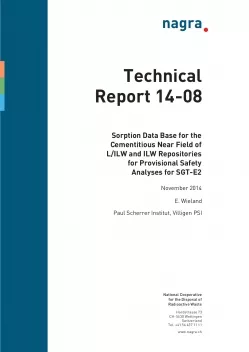
Technical Report NTB 14-08
Sorption Data Base for the Cementitious Near Field of L/ILW and ILW Repositories for Provisional Safety Analyses for SGT-E2
The near field of the planned Swiss repositories for low- and intermediate-level waste (L/ILW) and long-lived intermediate-level waste (ILW) consists of large quantities of cementitious materials. Hardened cement paste (HCP) is considered to be the most important sorbing material present in the near field of L/ILW and ILW repositories. Interaction of radionuclides with HCP represents the most important mechanism retarding their migration from the near field into the host rock.
This report describes a cement sorption data base (SDB) for the safety-relevant radionuclides in the waste that will be disposed of in the L/ILW and ILW repositories. The current update on sorption values for radionuclides should be read in conjunction with the earlier SDBs CEM-94 (Bradbury & Sarott 1994), CEM-97 (Bradbury & Van Loon 1997) and CEM-02 (Wieland & Van Loon 2002). Sorption values have been selected based on procedures reported in these earlier SDBs. The values are revised if corresponding new information and/or data are available. The basic information results from a survey of sorption studies published between 2002 and 2013. The sorption values recommended in this report have either been selected from in-house experimental studies or from literature data, and they were further assessed with a view to the sorption values recently published in the framework of the safety analysis for the planned near surface disposal facility in Belgium.
The report summarizes the sorption properties of HCP and compiles sorption values for safety-relevant radionuclides and low-molecular weight organic molecules on undisturbed ("fresh") and degraded HCP.
A list of the safety-relevant radionuclides is provided based on the currently available information on radionuclide inventories. The radionuclide inventories are determined by the waste streams to be disposed of in the L/ILW and ILW repositories. Information on the elemental and mineral composition of HCP was obtained from hydration studies (Lothenbach & Wieland 2006). The concentrations of the most important impurity elements in cement were obtained from dissolution studies on HCP. In this report, particular emphasis is placed on summarizing our current knowledge of the uptake mechanisms of safety-relevant radionuclides and the role of the uptake-controlling cement minerals.
In the disposal caverns, HCP is influenced by internal geochemical processes, such as carbonation due to the generation of CO2 in the course of the degradation of organic waste materials or due to the dissolution of metallic waste materials, and by externally induced geochemical processes, such as degradation due to interaction of inflowing saline and non-saline groundwater from the host rock. These processes can change the mineral composition of HCP and/or the composition of the pore solution, which could have an effect on radionuclide uptake. The effect of these time-dependent changes on radionuclide uptake has been assessed for three characteristic stages of the degradation of HCP by the interaction with inflowing groundwater. The stages are differentiated based on results from reactive transport calculations, which allow the composition of HCP and the corresponding pore water to be determined (Kosakowski et al. 2014). The presently available mechanistic understanding of radionuclide uptake by cementitious materials (HCP, cement phases) in combination with the results from reactive transport modelling allows well-supported appraisal of sorption values for radionuclides in an evolving cementitious near field to be made.
Important organic and inorganic ligands, such as EDTA, CN-, and degradation products of spent basic anion-exchange resins (e.g. ammonia) and cellulose (i.e. isosaccharinic acid), as well as concrete admixtures (e.g. gluconic acid) and cement-derived near-field colloids are taken into account as potential perturbations which could reduce radionuclide uptake in the near field. Possible impacts of these perturbing factors on radionuclide mobility are considered and quantified in terms of sorption reduction factors.
This report further includes a preliminary appraisal of the diffusion parameters of cementitious materials for use in safety analysis in the framework of stage 2 of the Sectoral Plan for Deep Geological Repositories (SGT-E2). The parameters are selected on the basis of a survey of literature data. The parameters are consistent with those used in earlier national and international performance assessment-related studies and, furthermore, with the parameters used in reactive transport calculations carried out in the framework of SGT-E2 (Kosakowski et al. 2014).
